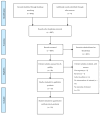Surgical Treatment of Neuropathic Chronic Postherniorrhaphy Inguinal Pain: A Systematic Review and Meta-Analysis
- PMID: 38792355
- PMCID: PMC11122157
- DOI: 10.3390/jcm13102812
Surgical Treatment of Neuropathic Chronic Postherniorrhaphy Inguinal Pain: A Systematic Review and Meta-Analysis
Abstract
Background/Objectives: Neuropathic chronic postherniorrhaphy inguinal pain (CPIP) is a serious adverse outcome following inguinal hernia repair surgery. The optimal surgical treatment for neuropathic CPIP remains controversial in the current literature. This systematic review aims to evaluate the effectiveness of various surgical techniques utilized to manage neuropathic CPIP. Methods: The electronic databases Medline, Embase, Web of Science, Cochrane Central, and Google Scholar were searched. Inclusion criteria were defined to select studies reporting on the efficacy of surgical interventions in patients with neuropathic CPIP. The primary outcome was postoperative pain relief, as determined by postoperative numerical or nonnumerical pain scores. Results: Ten studies met the inclusion criteria. Three surgical techniques were identified: selective neurectomy, triple neurectomy, and targeted muscle reinnervation. Proportions of good postoperative results of the surgical techniques ranged between 46 and 88 percent. Overall, the surgical treatment of neuropathic CPIP achieved a good postoperative result in 68 percent (95% CI, 49 to 82%) of neuropathic CPIP patients (n = 244), with targeted muscle reinnervation yielding the highest proportion of good postoperative results. Conclusions: The surgical treatment of neuropathic CPIP is generally considered safe and has demonstrated effective pain relief across various surgical techniques. Targeted muscle reinnervation exhibits considerable potential for surpassing current success rates in inguinal hernia repair surgery.
Keywords: inguinal hernia; neurectomy; neuropathic pain; postherniorrhaphy inguinal pain; surgical treatment; targeted muscle reinnervation.
Conflict of interest statement
The authors declare no conflicts of interest.
Figures



Similar articles
-
Neurophysiological and Clinical Effects of Laparoscopic Retroperitoneal Triple Neurectomy in Patients with Refractory Postherniorrhaphy Neuropathic Inguinodynia.Pain Pract. 2017 Apr;17(4):447-459. doi: 10.1111/papr.12468. Epub 2016 Jun 23. Pain Pract. 2017. PMID: 27334311
-
Quantitative validation of sensory mapping in persistent postherniorrhaphy inguinal pain patients undergoing triple neurectomy.Hernia. 2017 Apr;21(2):207-214. doi: 10.1007/s10029-017-1580-4. Epub 2017 Jan 13. Hernia. 2017. PMID: 28091815
-
Is pain control for chronic neuropathic pain after inguinal hernia repair using endoscopic retroperitoneal neurectomy effective? A meta-analysis of 142 patients from 1995 to 2022.Langenbecks Arch Surg. 2023 Jan 18;408(1):39. doi: 10.1007/s00423-022-02748-6. Langenbecks Arch Surg. 2023. PMID: 36652009 Free PMC article.
-
Risk factors of chronic pain after inguinal hernia repair: a systematic review.Innov Surg Sci. 2017 May 12;2(2):61-68. doi: 10.1515/iss-2017-0017. eCollection 2017 Jun. Innov Surg Sci. 2017. PMID: 31579738 Free PMC article. Review.
-
Pain control following inguinal herniorrhaphy: current perspectives.J Pain Res. 2014 May 29;7:277-90. doi: 10.2147/JPR.S47005. eCollection 2014. J Pain Res. 2014. PMID: 24920934 Free PMC article. Review.
Cited by
-
Chronic postoperative inguinal pain: prevention is better than 'cure'.Front Surg. 2025 Jul 23;12:1632219. doi: 10.3389/fsurg.2025.1632219. eCollection 2025. Front Surg. 2025. PMID: 40772256 Free PMC article. No abstract available.
-
A Novel One-Stop Multidisciplinary Clinic for Chronic Postoperative Inguinal Pain: Initial Experiences and Outcomes.J Abdom Wall Surg. 2025 Jun 16;4:14317. doi: 10.3389/jaws.2025.14317. eCollection 2025. J Abdom Wall Surg. 2025. PMID: 40589462 Free PMC article.
References
-
- International Association for the Study of Pain Classification of chronic pain. Descriptions of chronic pain syndromes and definitions of pain terms. Prepared by the International Association for the Study of Pain, Subcommittee on Taxonomy. Pain. 1986;3:S1-226. - PubMed
Publication types
LinkOut - more resources
Full Text Sources
Miscellaneous

